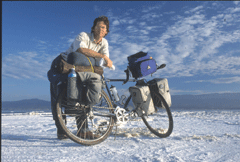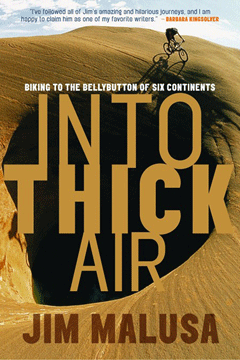Cycling to the Bottom of the World
Air Date: Week of May 30, 2008

Malusa at Lac Assal, Djibouti- the lowest point in Africa. (Courtesy of Jim Malusa)
Some folks travel to the world’s highest mountaintops. But Jim Malusa decided to do the opposite. Over a period of six years, Malusa biked his way to the lowest points on the face of the planet. A botanist, Malusa started in Australia and pedaled to what he calls “anti-summits” in Patagonia, Africa, as well as to Death Valley and the Dead Sea. Jim Malusa chronicles his adventures in the book, “Into Thick Air: Biking to the Bellybutton of Six Continents” and spoke with host Bruce Gellerman.
Transcript
GELLERMAN: Many mountaineers aspire to climb the highest peaks on Earth. For Jim Malusa, it's a race to the bottom. In 1996, Malusa, a botanist, hit the road on his bike seeking the lowest points on the planet. He started in Australia and it’s been downhill ever since. Over the next six years he pedaled to Death Valley, the Dead Sea, and the depths in between. Jim Malusa chronicles his adventures in his new book ‘Into Thick Air: Biking to the Bellybutton of Six Continents.’ Jim, welcome to Living on Earth!
MALUSA: Hello! I'm glad to be here.
GELLERMAN: Why the belly button?
MALUSA: Well, it began with a map that my wife and I found in the Times Atlas of the World. There was a place on that map in western China, a green spot, that was called Turpan. And looking closer we discovered it was 500 feet below sea level. We wondered what was going on down there, and chose a route that went through the mountains of Central Asia – Kyrgyzstan and Kazakhstan. And it ends up that it was very cold, and we got very hungry on the way, and by the time we got to Turpan it was an absolute delight to find it filled with watermelons and grapes and friendly folks, and it wasn't too hard to think the pits aren't so bad after all.
GELLERMAN: Are you the only person who's ever traveled by bike to the lowest places on the planet?

Cover of "Into Thick Air: Biking to the Bellybutton of Six Continents" (Sierra Club Books, 2008)
GELLERMAN: I knew that the Dead Sea was the lowest point on the planet, but I didn't realize that it was the lowest point by a lot compared to the other places. What is it – 1350 feet, is that right?
MALUSA: Yeah, no, you're right. There is – second place is far, far behind. It would be as if Mount Everest at 29,000 feet, and then the second place would be a mere 12,000 feet or so, right. The second lowest point is in Djibouti, there, and Turpan actually – they're around 500 feet below sea level – so Dead Sea is almost three times as deep.
The Caspian Sea is 92 feet below sea level, the shoreline. Salina Grande is about 140 feet, Death Valley 282 feet below sea level, Lake Eyre, Australia is about, oh, 49 feet below sea level.
GELLERMAN: You're a guy who likes to have a beer, a cold one. But along your way, you kind of indulge in local brew. You had, what, yerba mate?

Malusa biking across Australia. (Courtesy of Jim Malusa)
GELLERMAN: (laughs)
MALUSA: He insisted that it's always better with the testicle.
GELLERMAN: Well, I can't attest to that, but (laughs) I'll take his word for it.
MALUSA: (laughs)
GELLERMAN: Well, you also took somebody's word that Salina Grande, which is where you took your bike, was the lowest place in South America – and it wasn't!
MALUSA: Well, what a surprise that was. At that time, the Argentina Institute of Statistics – it was understood to be the low point. Patagonia's a big place and the last ten years they've discovered a place that was lower. After some initial dismay of saying, oh my lord, I've peddled to the wrong low point, now I have a reason to return.
GELLERMAN: When you were planning your trip to Djibouti, people weren't very positive about your going. Who was it, L.M. Nesbit called it the hellhole of creation?
MALUSA: Every tale from Djibouti from earlier in the 1900's has a horrible name, like the hellhole of creation. And the people developed quite an unsavory reputation, simply because of a little habit they had of castrating their enemies. And this has carried over well past the time where this has gone on, and the reputation persists.
And so I was, I suppose the right word would be terrified at first, and then I became less terrified, the more I learned. And once I started talking with people that had been to Djibouti, particularly a Swiss photographer who told me, well, you know, don't worry about the castrators, that's rubbish. There's occasional knife fights or stabbings, but it's not nearly as bad as Detroit, he insisted. And then I called the Djiboutian embassy themselves, and they said, well do you have bicycle experience? And I said, yes, I just rode my bike across Russia. And they said, what about the security in Russia? Isn't it dangerous? So people tend to believe that it's always more dangerous elsewhere.

Malusa at Lac Assal, Djibouti- the lowest point in Africa. (Courtesy of Jim Malusa)
MALUSA: Yes, when I was preparing to go to Djibouti, after I had convinced the embassy that the security in Russia really wasn't that bad, they said well don't worry about Djibouti at all because in the afternoon we'll be chewing the khat. They said it's a stimulant, something like coffee, and we only chew it from maybe one o'clock to around seven.
GELLERMAN: (laughs)
MALUSA: And they said, you won't be worried; you won't feel any stress. And I do like it – it is just what they say. It's a mild stimulant, and the reason I think its popularity is restricted to the Horn of Africa region and also in the Saudi peninsula, is not only because it's a class one offense or something by our own drug association, but because the chemicals that make it such a happy chew almost immediately decompose into the more useless things. And so it has to be – it has to be chewed essentially within a day.
And so Djibouti, a country which is hardly on the cutting edge of technology, and is the kind of country where you spend a lot of time waiting for things to happen, it's something of a miracle to watch khat delivery, okay, which would make FedEx envious. It comes exactly on time, every day, by jet. And then it's delivered by speedboats racing around the country along the coast, and it's quite an organization that they've got set up.
GELLERMAN: Well, Jim, where's your next ride taking you?
MALUSA: When I left Patagonia, I swore I'd never go back because of all the places in the world I went, that was the most rugged in terms of the weather. In the Andes, the wind and the rain, and in the desert, the wind. Now that I'm talking about it, now I'm saying, no I'm not going to do it! (laughs) But perhaps some day I'll get my nerve up and return.
GELLERMAN: Yeah you're making it sound mighty miserable. (laughs)
MALUSA: Well, bicycles can be miserable sometimes. Most of the time they're not. I like to think of them as – they intensify life. They make good times better, and they make bad times worse. You have to accept that if you're gonna go out – that when the conditions are good, boy do you feel good, but when things get bad, you can be stuck for a while too.
GELLERMAN: Well, Jim, thank you very much. I really appreciate you taking the time for us.
MALUSA: Thanks for having me.
GELLERMAN: Jim Malusa's book is called “Into Thick Air: Biking to the Bellybutton of Six Continents.”
Links
Living on Earth wants to hear from you!
Living on Earth
62 Calef Highway, Suite 212
Lee, NH 03861
Telephone: 617-287-4121
E-mail: comments@loe.org
Newsletter [Click here]
Donate to Living on Earth!
Living on Earth is an independent media program and relies entirely on contributions from listeners and institutions supporting public service. Please donate now to preserve an independent environmental voice.
NewsletterLiving on Earth offers a weekly delivery of the show's rundown to your mailbox. Sign up for our newsletter today!
 Sailors For The Sea: Be the change you want to sea.
Sailors For The Sea: Be the change you want to sea.
 The Grantham Foundation for the Protection of the Environment: Committed to protecting and improving the health of the global environment.
The Grantham Foundation for the Protection of the Environment: Committed to protecting and improving the health of the global environment.
 Contribute to Living on Earth and receive, as our gift to you, an archival print of one of Mark Seth Lender's extraordinary wildlife photographs. Follow the link to see Mark's current collection of photographs.
Contribute to Living on Earth and receive, as our gift to you, an archival print of one of Mark Seth Lender's extraordinary wildlife photographs. Follow the link to see Mark's current collection of photographs.
 Buy a signed copy of Mark Seth Lender's book Smeagull the Seagull & support Living on Earth
Buy a signed copy of Mark Seth Lender's book Smeagull the Seagull & support Living on Earth

